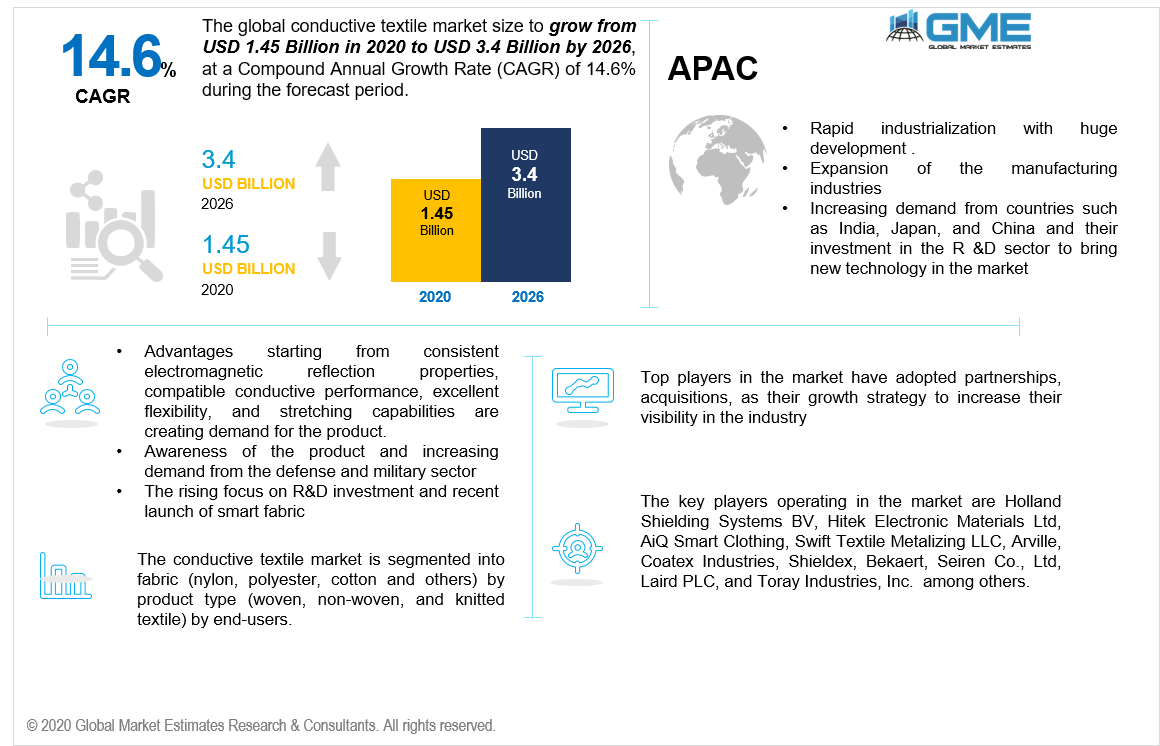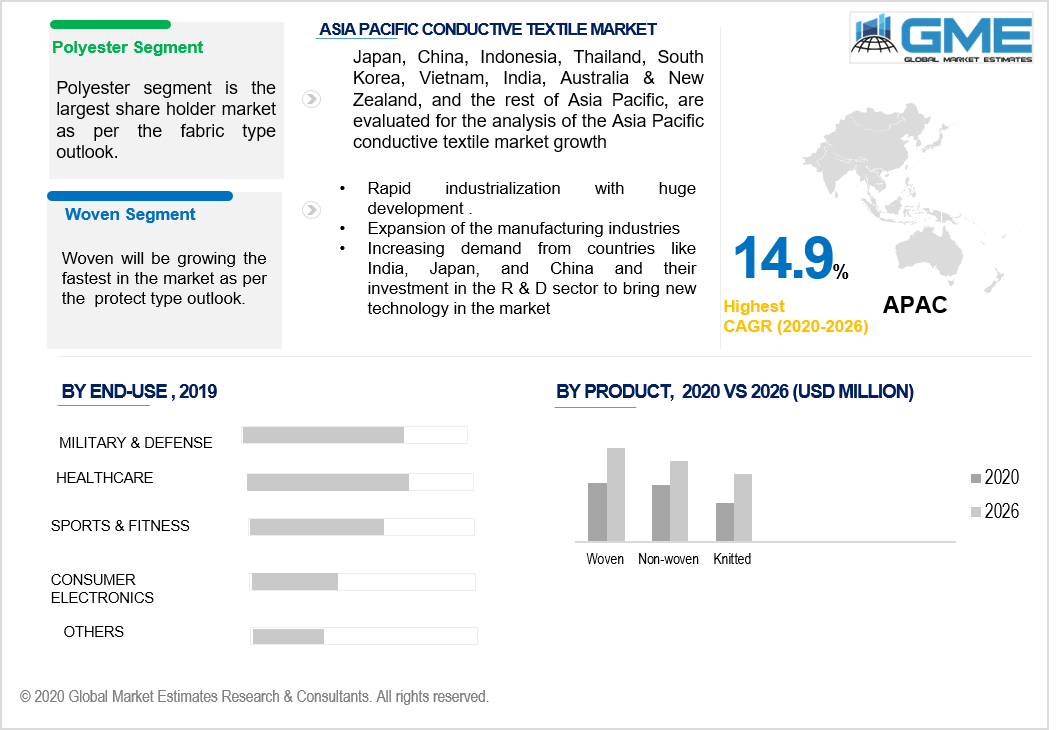
Global Conductive Textile Market Size, Trends & Analysis - Forecasts to 2026 By Fabric Type (Nylon, Cotton, Polyester, and Others); By Productive Type (Woven textile, Non-woven textile, and Knitted textile); By End-user (Military & Defense, Healthcare, Sports & Fitness, Consumer Electronics, Others); By Region (North America, Europe, Asia Pacific, MEA, CSA); End-User Landscape, Vendor Landscape, and Company Market Share Analysis & Competitor Analysis
Conductive Textile Market Insights
As per the studies performed by GME, the conductive textile market will register significant growth within the conjecture span of 2020-2026. The conductive textile is bifurcated into two types, the first one is the intrinsically conductive textiles and the second textiles are which gain conductivity on treatment. The conductive textile is a fabric made up of metal strands that are woven, coated, or blended during the formation of the textile. Silver, nickel, gold, titanium, and carbon care are the conductive metals utilized by the textile. These textiles can conduct electricity and are therefore used in a wide number of end-user industries. The prime function of the product is to manage electromagnetic waves and shield static interference owing to its flexible properties and its ability to be used in the existing wire machinery and textiles.
The conductive textile offers various advantages starting from consistent electromagnetic reflection properties, compatible conductive performance, excellent flexibility, and stretching capabilities that create demand for the product in the modern time. Awareness of the product and increasing demand from the defense and military sector is generating huge revenue and is expected to perform even better in the aforementioned period. The rising focus on R&D investment and the recent launch of smart fabric is estimated to build opportunities for the key players operating around the globe in the coming tenure. However high manufacturing cost associated with the conductive textile is the major hurdle for the growth of the market.

Conductive Textile Market: By Fabric Type
Nylon, cotton, polyester, and others are the types of fabrics used in the conductive textile industries. Polyester based conductive textiles are the second largest revenue builder of the market. The polyester segment owns some prime properties such as the fabric is strong, provides resistance to various chemicals and shrinking behavior which helped it to be used in raw material making for conductive wearables such as sports wears, and jackets that would propel the market demand.
Also, nylon showed the highest demand in the Asia-Pacific region owing to increasing awareness and demand of the nylon fabric with some notable manufacturing base.
Conductive Textile Market: By Product Type
The three types of products of conductive textiles are woven, non-woven, and knitted textiles. The woven segment has become popular in the eye of various manufacturers owing to its excellent performance in terms of conductivity shielding. However, with time non-woven textile had to gain the momentum to build revenue and is currently in the second position as the largest revenue builder of the globe. The reason behind this remarkable growth is its abrasion resistance, outstanding repellency from water, flame resistance.
Conductive Textile Market: By End-User
The end-user domain of the conductive textile market can be studied as military & defense, healthcare, consumer electronics, and others. Military and defense have gained momentum in the last few years. Due to the growing usage of conductive wearables that monitors the battlefield, aid communication, monitor temperature and track the health of the soldiers, the military & defense segment will dominate the market in the coming years also. Increasing investments by the government of various economically stable countries in the military sector have built huge opportunities for the conductive textile market.

Conductive Textile Market: By Region
Asia-Pacific is the fastest-growing region for the conductive textile market in present times. Rapid industrialization with huge development and expansion of the manufacturing industries are the driving factors for the conductive textile market in the Asia-Pacific region. Increasing demand from countries such as India, Japan, and China and their investment in the R &D sector to bring new technology in the market is creating opportunities for the product to target a wide range of end-users.
Europe is expected to dominate the conductive textile market in the forecast period due to the presence of technologically advanced infrastructure, skilled workforce, and automotive heritage.
Conductive Textile Market Share and Competitor Analysis
The key players operating in the market include Holland Shielding Systems BV, Hitek Electronic Materials Ltd, AiQ Smart Clothing, Swift Textile Metalizing LLC, Arville, Coatex Industries, Shieldex, Bekaert, Seiren Co., Ltd, Laird PLC, and Toray Industries, Inc among others.
Please note: This is not an exhaustive list of companies profiled in the report.
In November 2020, AiQ Smart Clothing presented its products along with its shieldex products at the space tech expo in Europe. The company showcased the solution for flexibility, shielding, lightweight, and high electrically conductive textiles that can be installed in space stations, satellites, and many more.
In October 2020, Toray Industries came up with a textile that can quell other sources of odors, Mushon 4X. The company utilized several nanotechnologies in combination with other processing techniques to prevent odor.
Related Report: Global Antimicrobial Hospital Textiles Market Size, Trends & Analysis - Forecasts to 2026
Check the Press Release on Global Conductive Textile Market Report
We value your investment and offer free customization with every report to fulfil your exact research needs.
The Global Conductive Textile Market has been studied from the year 2017 till 2026. However, the CAGR provided in the report is from the year 2018 to 2026. The research methodology involved three stages: Desk research, Primary research, and Analysis & Output from the entire research process.

The desk research involved a robust background study which meant referring to paid and unpaid databases to understand the market dynamics; mapping contracts from press releases; identifying the key players in the market, studying their product portfolio, competition level, annual reports/SEC filings & investor presentations; and learning the demand and supply side analysis for the Conductive Textile Market.

The primary research activity included telephonic conversations with more than 50 tier 1 industry consultants, distributors, and end-use product manufacturers.

Finally, based on the above thorough research process, an in-depth analysis was carried out considering the following aspects: market attractiveness, current & future market trends, market share analysis, SWOT analysis of the companies and customer analytics.

Tailor made solutions just for you
80% of our clients seek made-to-order reports. How do you want us to tailor yours?
OUR CLIENTS